If you want to know about the elements of design or auditorium design or residential building guidelines, please click the link.
Basement design is an important aspect of architecture, particularly in residential and commercial buildings.
- The lower storey of a building, below or partly below ground level.

1) Extended basement
- Extended Basement means the construction of floor(s) below the ground leaving a minimum setback of 6.0 metre all-round from the plot boundary for the purpose of fire tender movement.
- The top slab of basement to flush with the ground level and such slab to be designed for fire tender load with adequate mechanized ventilation.
2) Sunken courtyard
- Sunken courtyard up to 3 m in depth from the ground level as ‘light well’ within building envelope shall be permitted for light and ventilation for basement area, provided all concerns relating to drainage are taken care of.
3) Basic points (guideline) for basement design
Basic points are considering for designing any type of Basement
- The basement shall not be used for residential purposes.
- The construction of the basement shall be allowed by the Authority in accordance with the land use and other provisions specified under the Development Control Rules.
- The following uses shall be permitted in the basements
- Storage of household or other goods of ordinarily non-combustible material,
- Strong rooms, bank cellars, etc.,
- Air conditioning equipment and other machines used for services and utilities of the building; and
- Parking spaces
- The Authority may also consider permitting mercantile occupancy as well as institutional occupancy for medical, health care services involving radiation facilities in the first basement subject to compliance of all requirements for fire safety in accordance with NBC ‘Fire and Life Safety’ of the Code and necessary measures for required lighting, ventilation and water supply, drainage and sanitation.
- The basements can be permitted below the ground and beyond the building lines at ground level subject to a clear minimum front margin of 4.5 m and side and rear margins of 3 m, and further subject to non-habitable uses and provision for mechanical ventilation and all safety provisions and drainage as shown in the figure below.
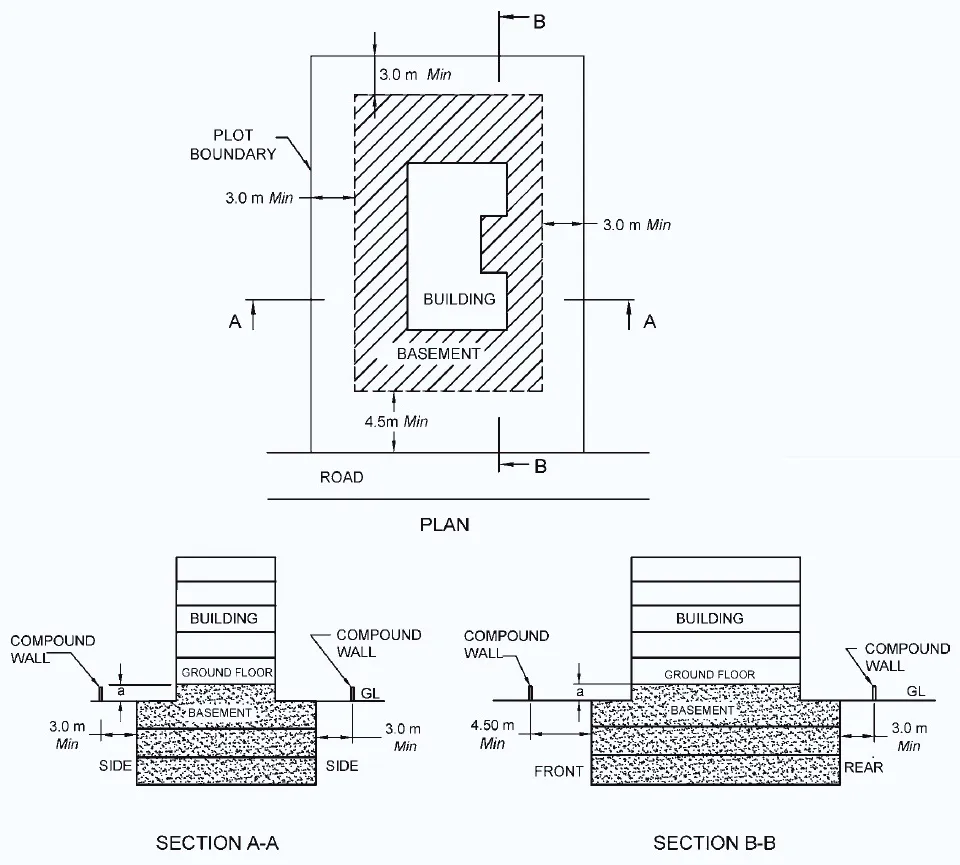
- However, it is essential that the basement top slab below the external circulation at ground level should be designed for fire-fighting vehicular loads as given in below.
For high rise buildings and special buildings, the following additional provisions of means of access shall be ensured:
- The width of the main street on which the building abuts shall not be less than 12 m and one end of this street shall join another street not less than 12 m in width.
- The road shall not terminate in a dead end; except in the case of residential building, up to a height of 30 m.
- The approach to the building and open spaces on all its sides shall be not less than 6 m in width, and a turning radius of minimum 9 m shall be provided for fire tender movement of fire tenders weighing up to 45 t.
- The same shall be hard surface capable of taking the mass of fire tender, weighing up to 45 t minimum.
- For heavier fire tenders, the minimum width, turning radius and the hard surface capable of taking the fire tender loads shall be as per the requirement laid down by the Fire Department.
- The layout for the open space for fire tender movement shall be done in consultation with the Chief Fire Officer of the city, which shall be kept free of obstructions and shall be motorable.
- The compulsory open spaces around the building shall not be used for parking.
- The main entrance to the plot shall be of adequate width to allow easy access to the fire engine and in no case shall it measure less than 6 m.
- The entrance gate shall fold back against the compound wall of the premises, thus leaving the exterior access way within the plot free for movement of fire tender.
- If the main entrance at the boundary wall is built over, the minimum clearance shall be 4.5 m.
The basement shall have the following requirements:
a) Every basement shall be in every part at least 2.4 m in height from the floor to the underside of the roof slab or ceiling.
b) Adequate ventilation shall be provided for the basement.
- The ventilation requirements shall be the same as required by the particular occupancy according to byelaws. Any deficiency may be met by providing adequate mechanical ventilation in the form of blowers, exhaust fans, air conditioning systems, etc;
c) The height of the ceiling of any basement shall be minimum 0.9 m and the maximum, 1.2 m above the average surrounding ground level.
- However, in case of parking, mercantile or business occupancy at ground floor, minimum height of the ceiling of the basement may be 0.3 m above the average surrounding ground level subject to mechanical ventilation being provided as shown in the figure below.

d) Adequate arrangements shall be made such that surface drainage does not enter the basement.
e) The walls and floors of the basement shall be watertight and be so designed that the effects of the surrounding soil and moisture, if any, are taken into account in design and adequate damp proofing treatment is given.
f) The access to the basement shall be separate from the main and alternative staircase providing access and exit from higher floors.
- Where the staircase is continuous in the case of buildings served by more than one staircase, the same shall be of enclosed type serving as a fire separation from the basement floor and higher floors.
- Open ramps shall be permitted if they are constructed within the building line subject to the provision of (d);
g) Access to basements through ramps shall be permitted subject to provision of (d).
- The requirements for the ramps shall be in accordance purpose of building as given in below.
- Requirements for ramp for vehicles as shown in figure
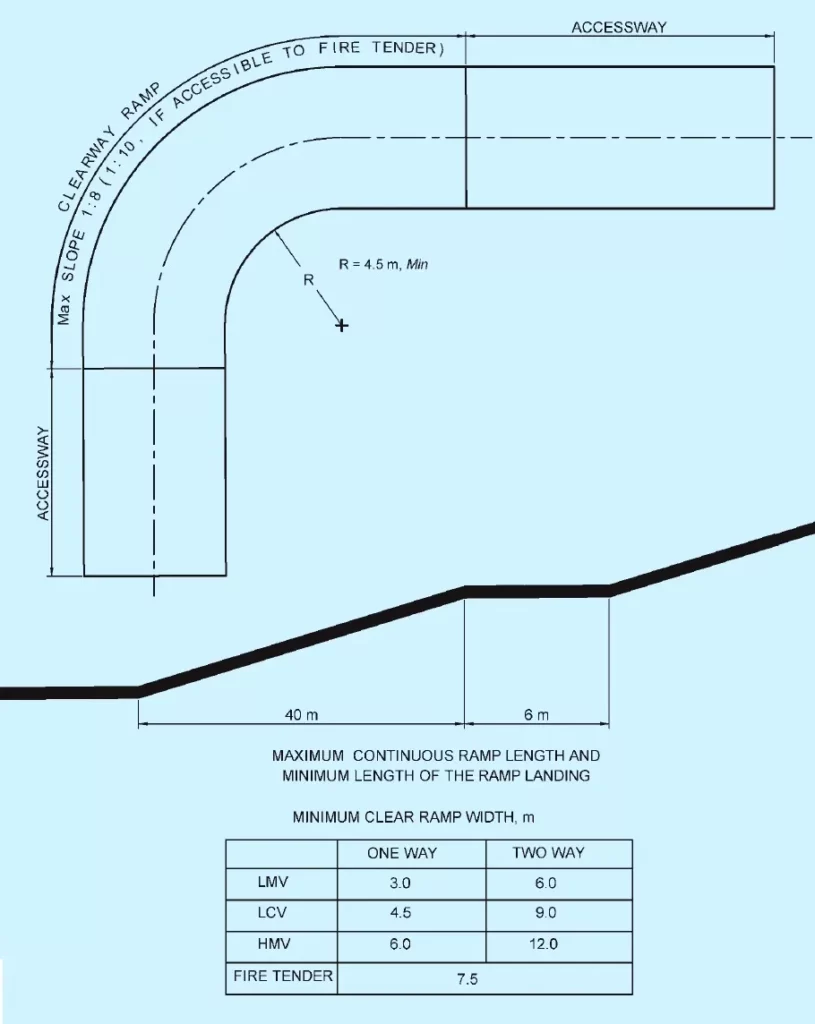
- One way ramp of clear width of minimum 3.0 m and two-way ramp with clear width of minimum 6.0 m shall be provided for LMV.
- One way ramp of clear width of minimum 4.5 m and two-way ramp with clear width of minimum 9.0 m shall be provided for LCV.
- One way ramp of clear width of minimum 6.0 m and two-way ramp with clear width of minimum 12.0 m shall be provided for HMV.
- Ramp slope shall be maximum 1 in 8.
- After a 40 m length of continuous ramp, a flat surface of minimum 6.0 m length shall preferably be provided please see Figure above.
- If podium is accessible to fire tender, minimum 7.5 m wide ramp shall be required for fire engine access with maximum slope of 1 in 10.
h) For all public buildings and uses including group housing, having basement going up to more than one level, access to all levels shall also be provided through lift. The exit requirements in basements shall comply with the provisions as per Fire and Life Safety.
I) The area covered in the basement, stilt, podium, services area and all other covered area as the case may be, shall be counted towards the covered area for purpose of calculation of permit fees.
J) Provisions for sunken courtyard have been added for meeting the light and ventilation requirements for basement area.
K) The basement may vary between 33.33 and 50 percent of the plot area and is to be used for parking, servicing and for essential household storage without counting in FAR.
4) Parking area requirements
a) The off-street parking (on-site parking) spaces in a plot to be provided shall be in accordance with Annex A. The spaces given in Annex A shall be considered by the Authority in conjunction with the Development Rules, in force, if any.
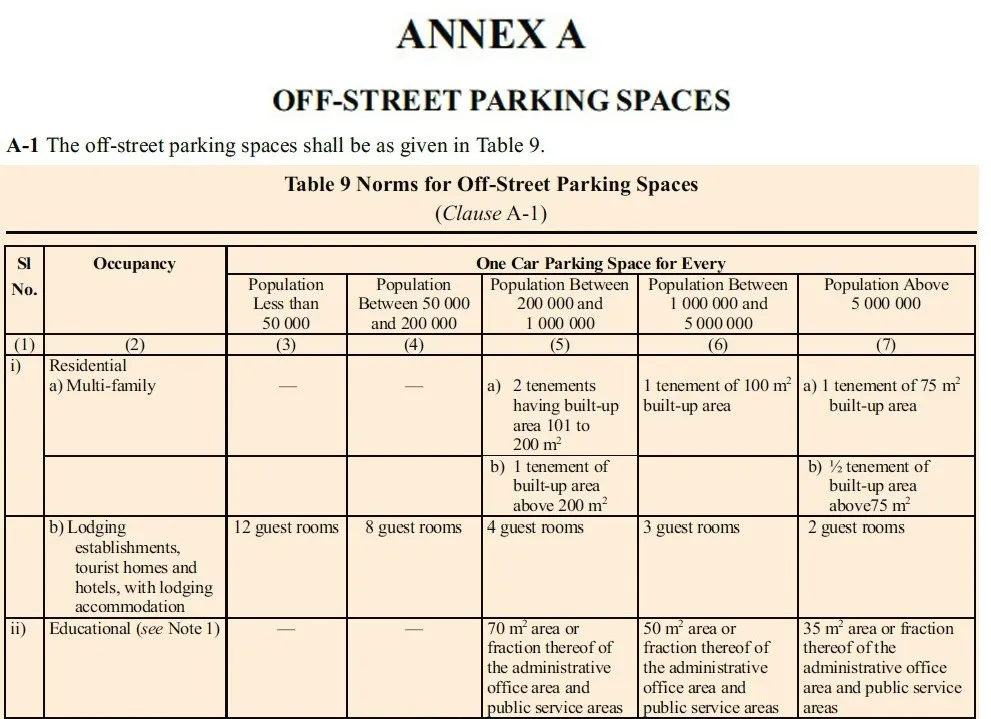

b) The spaces to be left out for off-street parking as given in below shall be in addition to the open spaces left out for lighting and ventilation purposes.
c) Further 50 percent of the open spaces required around buildings under 8 may be allowed to be utilized for parking or loading or unloading spaces, provided a minimum distance of 3.6 m around the building is kept free from any parking, loading or unloading spaces subject to the provisions of Fire and Life Safety.
d) Each off-street parking space provided for vehicles shall be as follows:
shall be as follows:
- For car, the minimum parking space to be 3 m × 6 m when individual parking space is required and 2.75 m × 5 m when common parking space is required.
- Space for scooter/two-wheeler and bicycle to be not less than 1.25 m2 and 1.00 m2, respectively.
- Area for each equivalent car space inclusive of circulation area is 23 m2 for open parking, 28 m2 for ground floor covered parking and 32 m2 for basement.
- For buildings of different occupancies, off street parking space for vehicles shall be provided as stipulated below:
i) Motor vehicles — Space shall be provided as specified in Annex A for parking motor vehicles (cars).


ii) Other types of vehicles — For non-residential building, in addition to the parking areas provided in (i) above, 25 to 50 percent additional parking space shall be provided for parking other types of vehicles and the additional spaces required for other vehicles shall be as decided by the Authority, keeping in view the nature of traffic generated in the city.
For residential occupancy, space for motorcycle/ scooter/cycle/two-wheeler shall be provided at the rate of one for each tenement.
f) Off-street parking space shall be provided with adequate vehicular access to a street; and the area of drives, aisles and such other provisions required for adequate maneuvering of vehicle shall be exclusive of the parking space stipulated in these provisions.
g) If the total parking space required by these provisions is provided by a group of property owners for their mutual benefits, such use of this space may be construed as meeting the off-street parking requirements under these provisions, subject to the approval of the Authority.
h) In buildings of mercantile (commercial), industrial and storage type, in addition to the parking spaces provided, a space at the rate of 3.5 m × 7.5 m, shall be provided for loading and unloading activities, for each 1000 m2 of floor area or fraction thereof.
I) Parking spaces shall be paved and clearly marked for different types of vehicles.
j) Apart from parking at ground level, provision of underground or multi-storeyed parking or podium parking may be permitted.
- The parking of vehicles at different level may also be mechanized.
- In the case of parking spaces provided in basement(s), at least two ramps of width and slope (as given above) shall be provided, located preferably at opposite ends.
- In case of underground/multi-storeyed parking, special measures with regard to fire safety shall be taken ‘Fire and Life Safety’
5) Parking layout
- Parking spaces are usually outlined by 12-20mm wide yellow or white painted lines.
- When parking is facing a wall, these lines are often painted at a height of up to 1 m for better visibility.
- Guide rails in the floor along the side have also proved popular for demarcation of parking limits, and can be about 50-60cm long, 20cm wide and 10 cm high.
- Where vehicles are parked in lines facing walls or at the edge of the parking deck in a multi-storey carpark, it is common practice to provide buffers, restraining bars or railings up to axle height to prevent cars from going over the edge.
- Where cars are parked face to face, transverse barriers about 10cm high can be used to act as frontal stops.
- Overhang on vehicles must be taken into account – figure-1.
- For lining up in front of a wall, a stop rail or rubber buffer will be sufficient – figure-1.

- Garage parking spaces for cars should have an overall length of more than 5m and a width of 2.30m, but parking spaces for the disabled should be more than 3.50m wide.
Figure-1 (Parking parallel to the road)
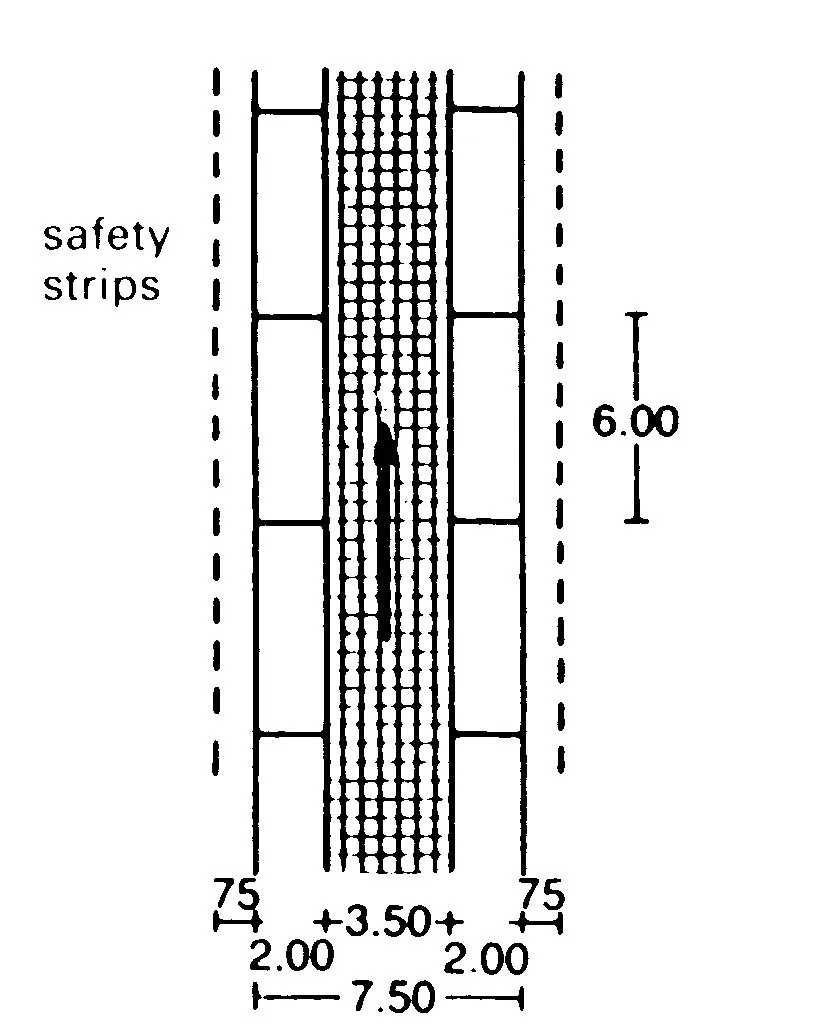
Figure -2 (30° oblique spaces, easy entry and exit, but for use only with one-way traffic)
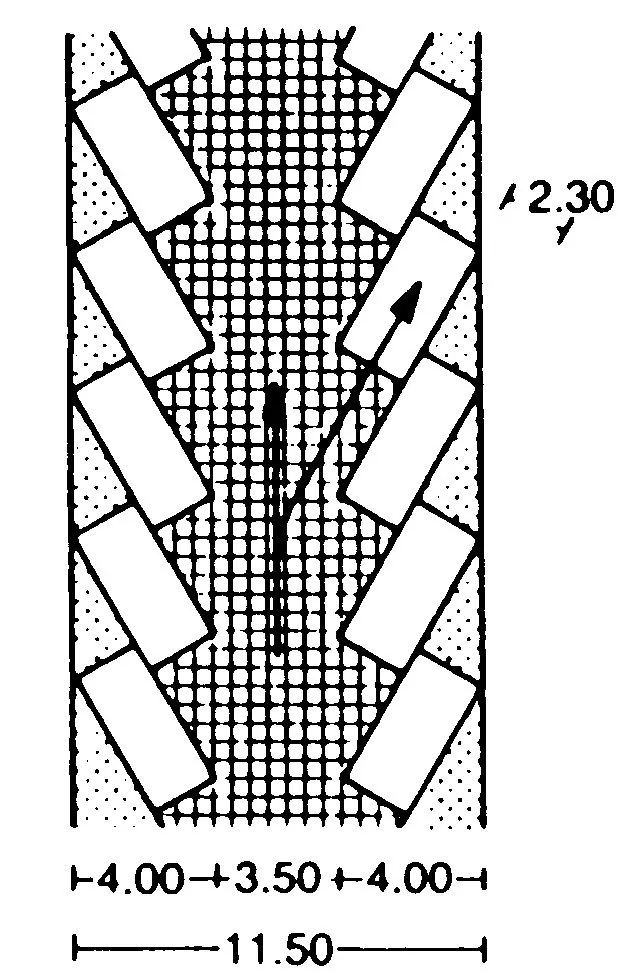
Figure -3 (45° oblique parking, oneway traffic only)

Figure -4 (60° oblique parking, oneway traffic only)

Figure -5 (90° entry/exit to parking spaces for two-way traffic Parking space 2.50 m wide)

Figure -6 (90° entry/exit to parking spaces, for two-way traffic Parking space 2.30 m wide)

Figure -7 (45° angle parking, oneway traffic only)
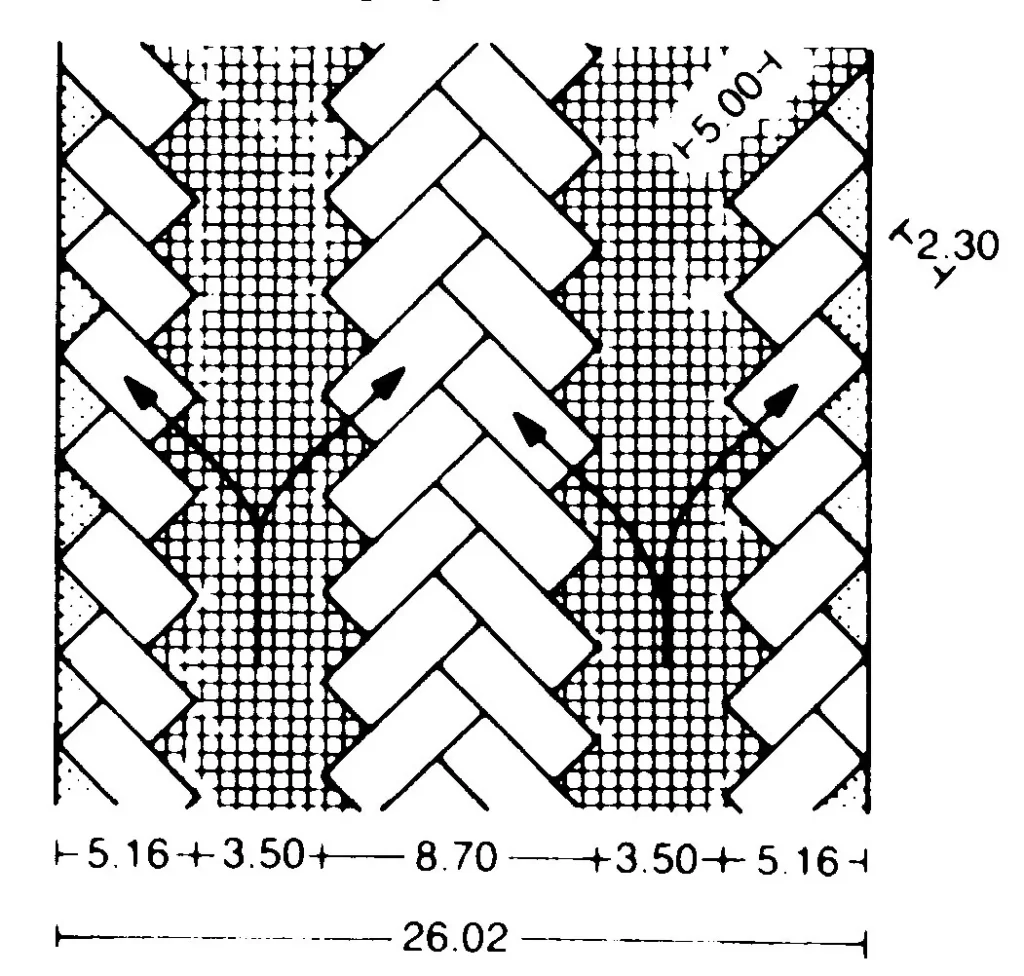
Figure -8 (Parking for one-way traffic (with spaces for plants))

Figure -9 (60° angled parking, one way traffic)
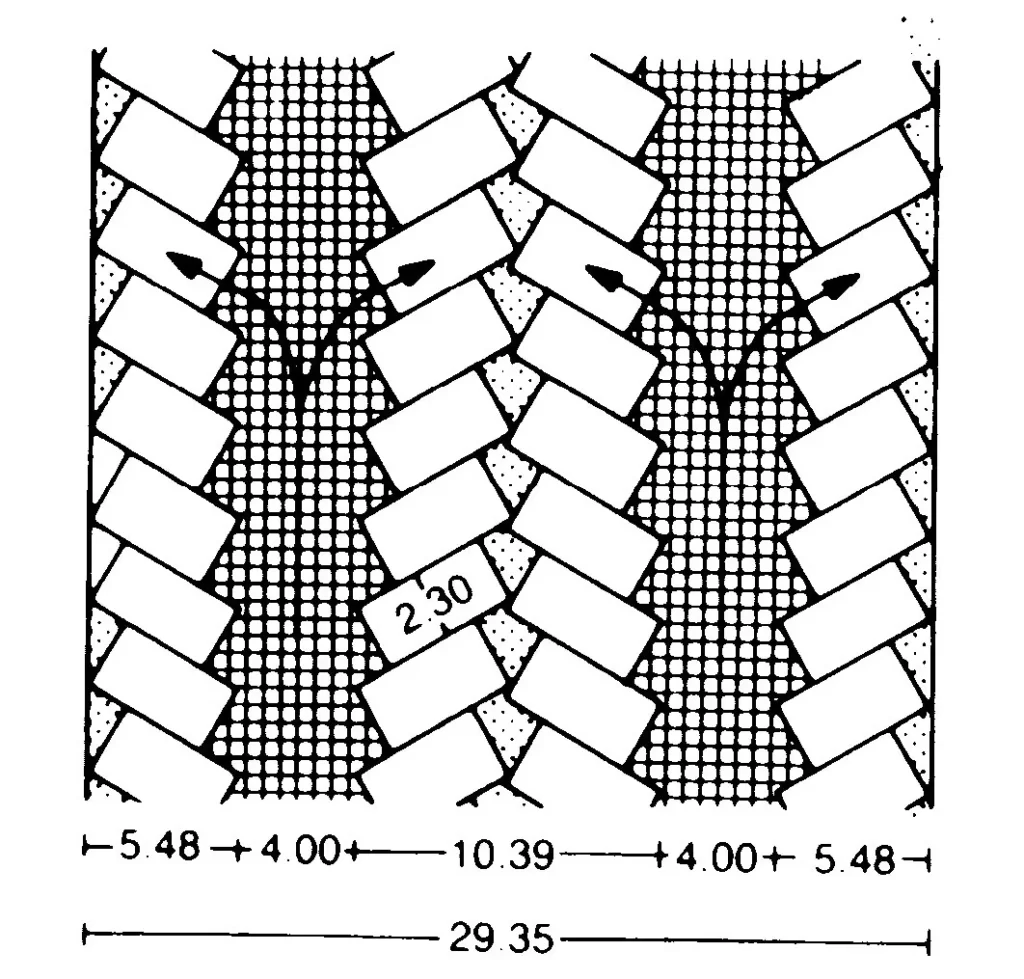
Figure -10 (90° parking, 5.5 m wide road Parking spaces 2.5 m wide)
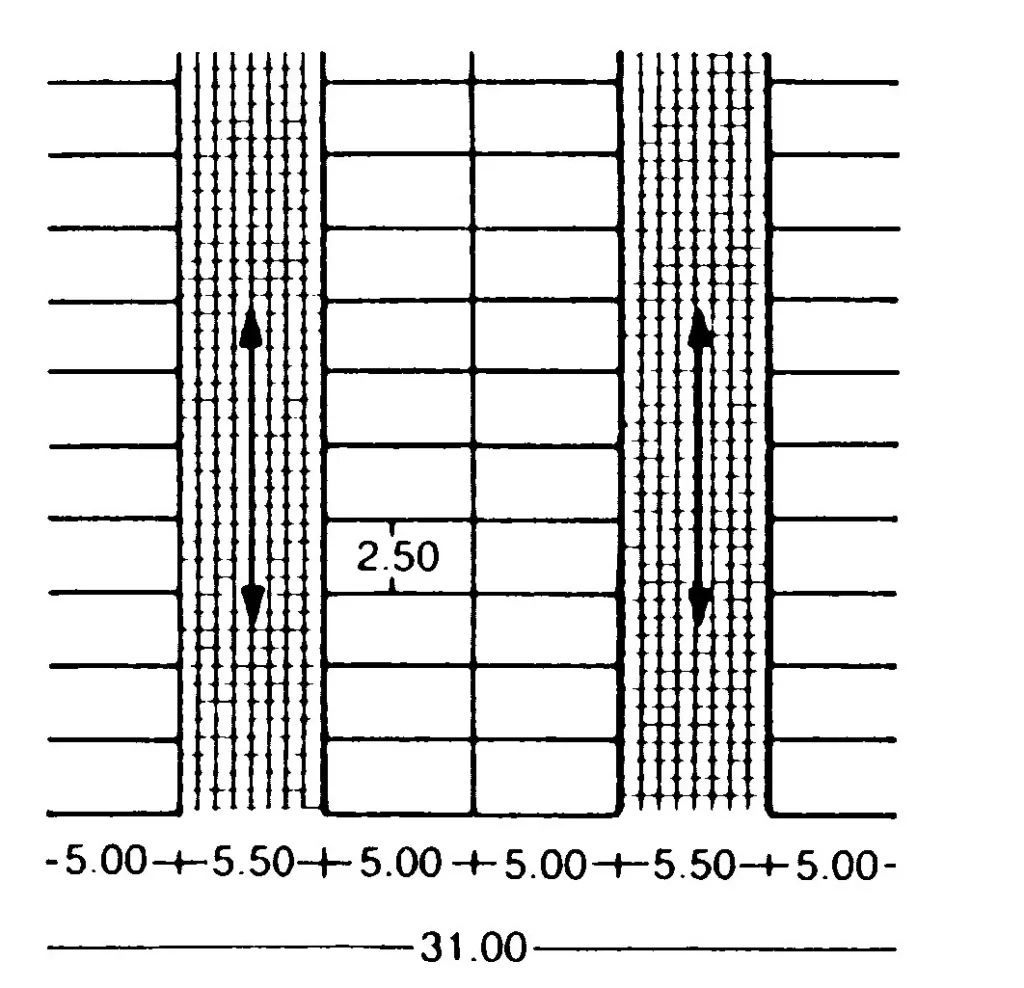
Figure -11 (Standard car)
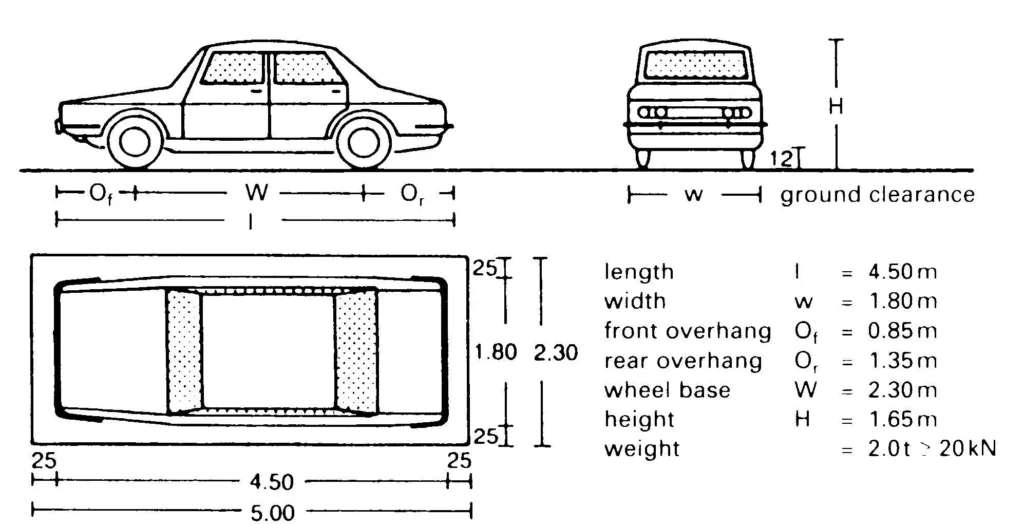
Figure -12 (Oblique parking layout)
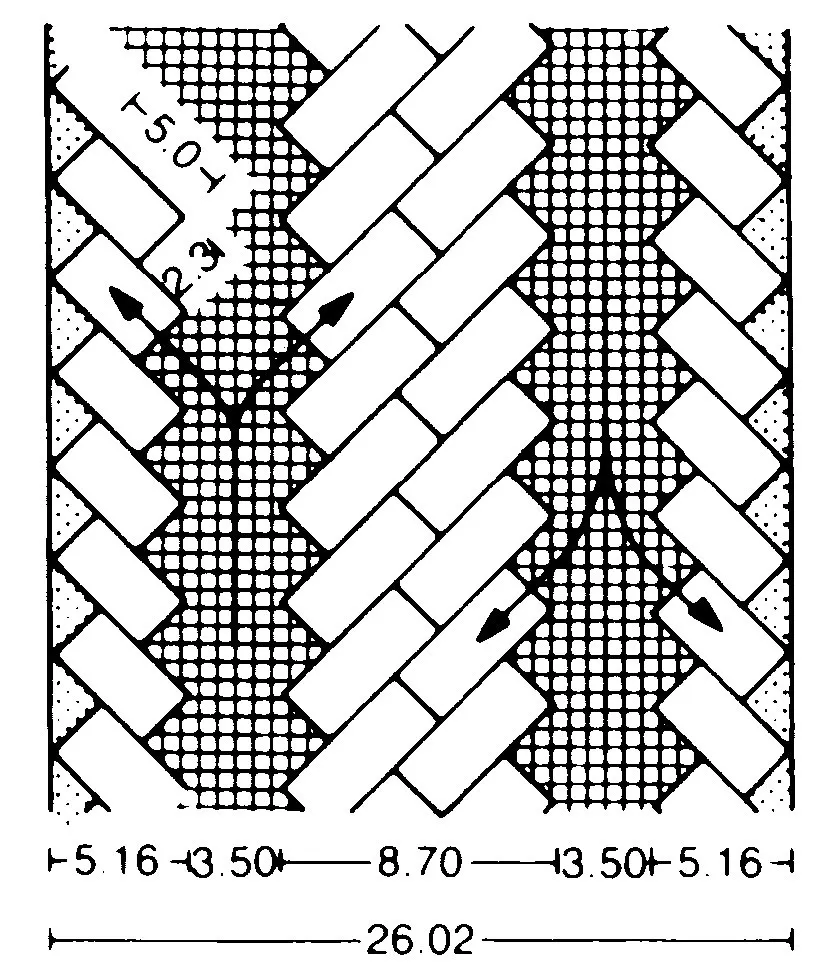
Figure -13 (Stop rails and buffers)
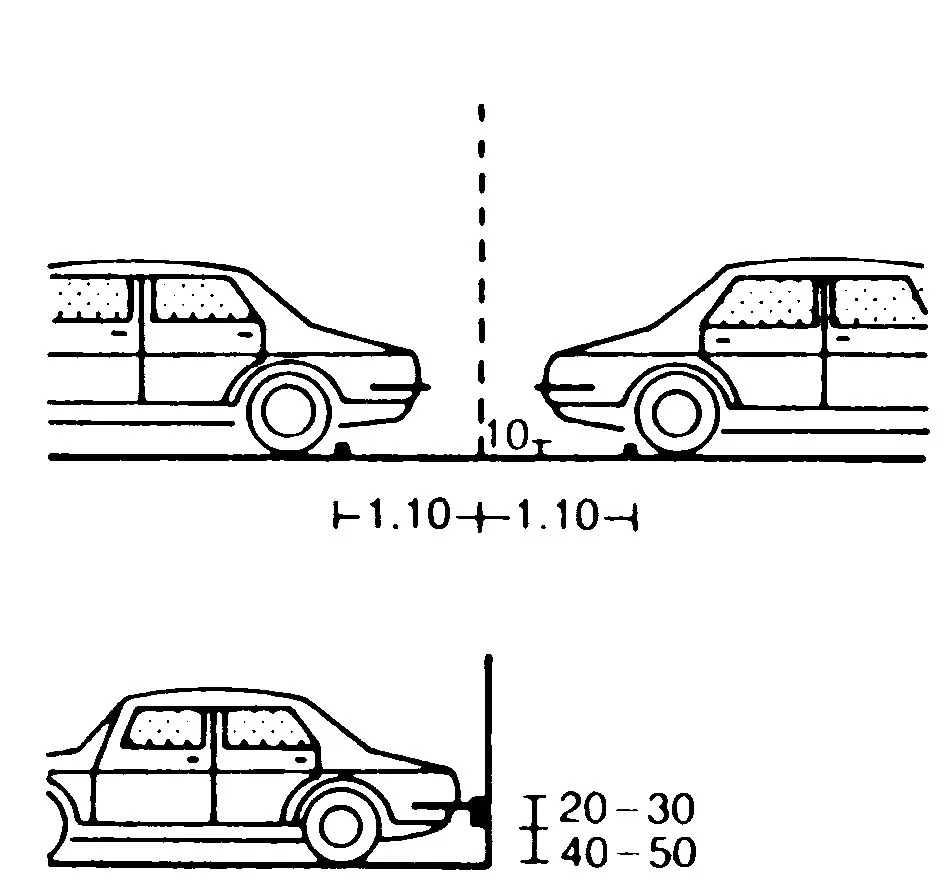
In architectural design, it’s also important to ensure proper ventilation, address structural issues and plan for egress, consider natural light, plan for utility access, and choose appropriate finishes. By taking these factors into account, you can create a functional, safe, and inviting basement space.
Hi team,
I have one plot 20X50. I want to use ground floor for car parking because we have 2 cars and 2 two wheelers. So just want to confirm can we build our ground floor below 4 feet of ground level?